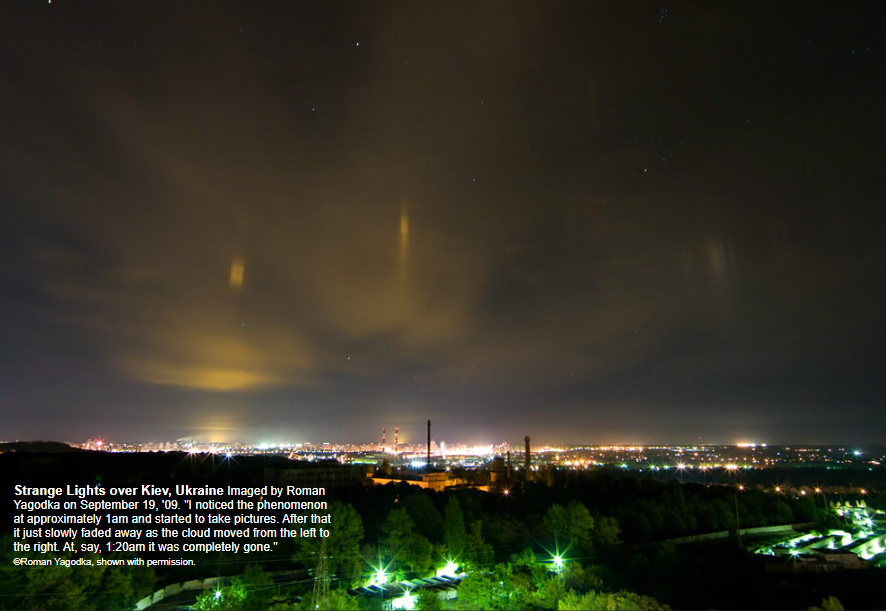Lights in a Kievan sky
Lights in a Kievan Sky: Exploring the Phenomenon of Reflected City Lights
Have you ever looked up at the night sky and been mesmerized by the sight of strange lights? Such was the case in Kiev, Ukraine, on September 19, '09, when Roman Yagodka captured a fascinating phenomenon on camera. He noticed the unusual lights at around 1 am and began taking pictures. Over time, the lights slowly faded away as the clouds moved from left to right, completely disappearing by 1:20 am.
Upon closer examination of the images, it becomes clear that these lights are actually unshielded city lights being reflected by plate-shaped ice crystals present in the thin clouds. Normally, these reflections form pillar shapes, but in this case, they were highly localized. This suggests that the ice crystals were aligned almost horizontally without significant tilts and were present in a thin layer.
Roman Yagodka took it upon himself to estimate the heights of these crystals and identify the sources of the lights. He determined that the lights on the left side of the image originated from a massive array of greenhouses, spanning 600x600 meters, located 26 kilometers away. In the center of the image, a smaller array of greenhouses measuring 500x300 meters, situated 20 kilometers away, produced the central light. The multiple reflections on the right side of the image were caused by the lights of an airport located 29 kilometers away. Roman assumed that the reflecting crystals were roughly halfway between the lights and the camera.
To help determine the scale of the image, Roman relied on the stars visible in the photograph. Aldebaran in Taurus appeared on the right side, Capella in Auriga occupied the top center position, and the Pleiades were just below "Galleries." These celestial markers provided valuable reference points for calculating the angular scales of the image.
Calculations suggest that the clouds responsible for this phenomenon were at heights ranging from 4 to 4.5 kilometers (13 to 15,000 feet). These cloud formations are likely to be altostratus or unusually low cirrus clouds, both known to contain ice crystals. It is interesting to note that the ground temperature at the time was relatively warm, around +10°C. This makes the observed lights even more unusual since artificial light pillars are typically associated with subzero temperatures and lower ice fog.
The phenomenon captured by Roman Yagodka in Kiev is a captivating example of how light can interact with the atmosphere in unexpected ways. By understanding the underlying mechanisms, we gain insight into the fascinating world of atmospheric optics. Here are some key takeaways from this extraordinary event:
- The lights were caused by unshielded city lights being reflected by plate-shaped ice crystals in thin clouds.
- The highly localized nature of the reflections suggests that the ice crystals were aligned nearly horizontally in a thin layer.
- The heights of the reflecting crystals were estimated to be roughly halfway between the lights and the camera.
- Stars visible in the photograph, such as Aldebaran, Capella, and the Pleiades, helped determine the angular scales of the image.
- The calculated cloud heights were around 4 to 4.5 kilometers (13 to 15,000 feet), indicating altostratus or unusually low cirrus clouds.
- The ground temperature at the time was relatively warm, around +10°C, making the presence of artificial light pillars even more unusual.
The world of atmospheric optics continues to surprise us with its intricate and captivating phenomena. Through careful observation and analysis, we can unravel the mysteries of these extraordinary events and gain a deeper appreciation for the beauty and complexity of our atmosphere. So, next time you find yourself gazing up at the night sky, keep an eye out for any unexpected lights that may reveal the hidden wonders of atmospheric optics.

Strange Lights over Kiev, Ukraine Imaged by Roman Yagodka on September 19, '09. "I noticed the phenomenon at approximately 1am and started to take pictures. After that it just slowly faded away as the cloud moved from the left to the right. At, say, 1:20am it was completely gone."
©Roman Yagodka, shown with permission.

These are unshielded city lights being reflected by plate shaped ice crystals in the thin clouds. Normally the reflections form a pillar shape but these ones are quite localised indicating perhaps that the crystals were aligned nearly horizontal without any significant range of tilts and in a thin layer.
Roman estimated the heights of the crystals. He knew the sources of the lights. At left the lights were from a huge array (600x600m) of greenhouses 26km distant. A smaller array of greenhouses (500x300m) 20km distant produced the central light. The multiple reflections at right were from the lights of an airport 29km distant. He assumed that the reflecting crystals were roughly half way between the lights and the camera. The stars help determine the angular scales of the image. At right is Aldebaran in Taurus, Capella in Auriga is at top centre and the Pleiades are just below �Galleries�.
The calculated cloud heights were 4-4.5km (13 to 15,000 ft) � perhaps altostratus or unusually low cirrus and both known to contain ice crystals. The ground temperature was a relatively warm +10C. The lights are unusual because artificial light pillars are better known in subzero temperature weather when the reflecting crystals are in lower ice fog.
Note: this article has been automatically converted from the old site and may not appear as intended. You can find the original article here.
Reference Atmospheric Optics
If you use any of the definitions, information, or data presented on Atmospheric Optics, please copy the link or reference below to properly credit us as the reference source. Thank you!
-
<a href="https://atoptics.co.uk/blog/lights-in-a-kievan-sky/">Lights in a Kievan sky</a>
-
"Lights in a Kievan sky". Atmospheric Optics. Accessed on December 23, 2024. https://atoptics.co.uk/blog/lights-in-a-kievan-sky/.
-
"Lights in a Kievan sky". Atmospheric Optics, https://atoptics.co.uk/blog/lights-in-a-kievan-sky/. Accessed 23 December, 2024
-
Lights in a Kievan sky. Atmospheric Optics. Retrieved from https://atoptics.co.uk/blog/lights-in-a-kievan-sky/.